
The United States is frequently referred to as the richest country on earth. The basis for this is the country’s gross domestic product, or GDP. At last count, the U.S. has a GDP of about $23 trillion, well above second-place China’s $17.7 trillion. However, GDP is only one way to measure wealth.
24/7 Wall St. used a different measure to determine the richest country in the world, gross national income per capita. Data for 193 countries and special regions came from the World Bank. By this measure, the United States barely cracks the top 10. (By contrast, these are the poorest countries in the world.)
Many of the richest countries in the world benefit from having large multinational corporations headquartered within their borders. Even if these companies earn money overseas, that income is counted towards the gross national income of the country where the business is based.
The world economic landscape has shifted to be increasingly more globalized and interconnected. As a result, many companies, including many that are headquartered in one of the nations on this list, have extended their footprint into dozens of countries and grown their valuation to tens of billions of dollars.
Other countries among the world’s richest are financially well off because they have an important natural resource, generally oil, that is valuable and abundant enough to create many billions of dollars worth of economic activity. Conversely, many others have very large and diverse economies that excel in a number of different fields. (Find out if any of the richest countries are also the happiest. These are the happiest countries in the world.)
Living in a wealthy country comes with numerous advantages, perhaps most importantly is health. Those in countries with high incomes are generally able to get access to better health care and food, and generally have very low maternal and child mortality. Most rich nations have a higher average life expectancy than the world average life expectancy.
The special administrative region of China located at China’s southern tip, Macau’s GNI per capita is $117,340 — nearly $100,000 higher than the worldwide GNI per capita. Macau also ranks as one of the world’s healthiest countries with an average life expectancy at birth of 84.2 years, the third highest in the world. Although it is known as the gambling capital of the world, Macau is also considered a tax haven as foreign earnings are not taxed.
Click here to see the richest countries in the world.
Click here to see our methodology.

25. Saudi Arabia
> GNI per capita: $47,790
> 2020 GDP: $1.6 trillion
> Population: 34.8 million
> Avg. life expectancy at birth: 75.1 years
Saudi Arabia is the 25th richest country in the world, with a gross national income per capita of $47,790. Worldwide, the GNI per capita is just $17,535. The kingdom ranks as one of the world’s wealthiest countries due mainly to its large oil and natural gas industry.
Saudi Arabia had $228 billion in exports in 2019, roughly 75% of which in the form of different types of petroleum. Oil production accounted for more than 24% of the nation’s total GDP, one of the highest shares of any nation in the world.
[in-text-ad]

24. France
> GNI per capita: $50,400
> 2020 GDP: $3.1 trillion
> Population: 67.4 million
> Avg. life expectancy at birth: 82.6 years
France is one of 24 countries in the world with a per capita income of more than $50,000. The Western European nation had a GDP of more than $3 trillion in 2020, one of just 10 countries in the world with such a large economy.
GNI per capita is a strong indicator of the standard of living in a country and correlates with better access to health care and improved health outcomes. The average life expectancy at birth in France is 82.6 years, nearly a full decade longer than the worldwide average life expectancy.

23. Australia
> GNI per capita: $51,420
> 2020 GDP: $1.3 trillion
> Population: 25.7 million
> Avg. life expectancy at birth: 82.9 years
Australia is the only country from the Oceania area of the world to rank among the richest countries. GNI per capita among the 25.7 million residents is$51,420, and the nation’s 2020 GDP was over $1.3 trillion, the 18th largest in the world.
For nearly all of the wealthiest countries in the world, exporting of goods and services account for a relatively large percentage of their GDP. Generally well above the 29.5% of the worldwide GDP comes from exports. Yet in Australia, exports account for less than 24% of economic output. This is likely due in part to the fact that the country’s export profile is not diverse, largely propped up by natural resources like iron ore and petroleum. This lack of economic diversity could hamper growth in the future.

22. Finland
> GNI per capita: $51,650
> 2020 GDP: $282.6 billion
> Population: 5.5 million
> Avg. life expectancy at birth: 81.8 years
Finland is one of the five Nordic countries, all of which rank among the 25 richest countries in the world. Finland is the least well-off of these five countries (which are Sweden, Iceland, Denmark, and Norway) with a GNI per capita of $51,650.
Finland scored an 85 out of 100 in Transparency International’s Corruptions Perceptions Index, tied for the third best score out of 180 ranked countries. Experts and business people consider the Nordic nation as relatively free of corruption, which means that people and businesses are able to work without concerns of being interfered with by corrupt practices. This lack of corruption helps promote economic growth through innovation.
[in-text-ad-2]

21. Germany
> GNI per capita: $55,220
> 2020 GDP: $4.5 trillion
> Population: 83.2 million
> Avg. life expectancy at birth: 80.9 years
Germany’s GNI per capita of $55,220 is more than triple the worldwide GNI per capita of $17,535. Like many of the other wealthiest nations, its economy is relatively diverse, with a number of major industries providing a wide range of goods and services, like automobiles, medicine, business services, and more. Economic diversity gives countries the ability to produce goods and services competitively, helping fuel economic growth.
With 83.2 million people, Germany is the second largest of the richest countries in the world, behind only the United States. It also ranks second on this list behind only the U.S. in terms of GDP. At $4.5 trillion, Germany’s GDP is the fifth largest in the world.
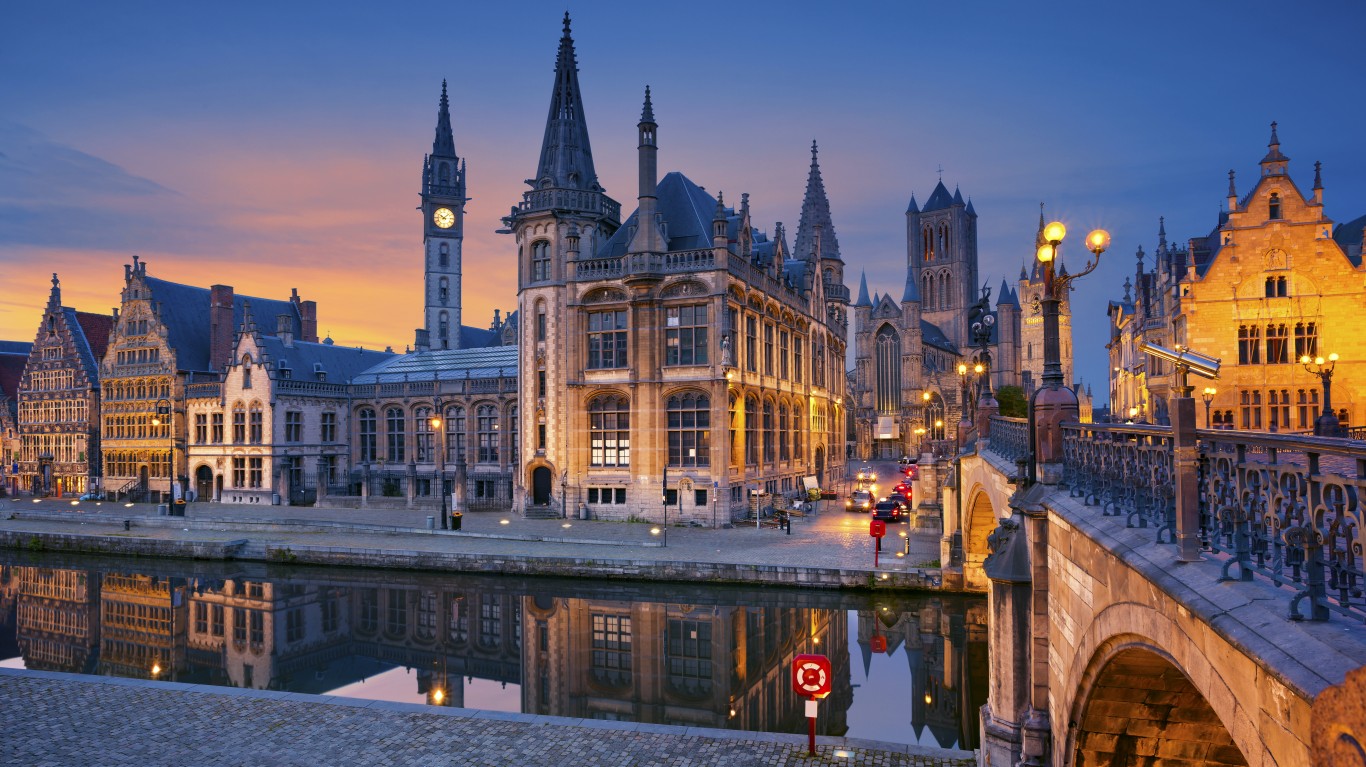
20. Belgium
> GNI per capita: $55,370
> 2020 GDP: $600.5 billion
> Population: 11.6 million
> Avg. life expectancy at birth: 81.7 years
Belgium has the 20th highest GNI per capita out of nearly 200 countries for which there is data, at $55,370. Like many other wealthy countries, the vast majority of Belgians live in urban areas, with access to a variety of jobs. Less than 2% of Belgians live in rural areas, and the country has an unemployment rate of 6.0%. Worldwide, the unemployment rate is 6.5%.
GNI per capita is a good indicator of standard of living in a country and tends to be associated with health care outcomes. Belgium has a life expectancy at birth of 81.7 years, nine full years longer than the worldwide life expectancy at birth of 72.7 years.
[in-text-ad]

19. Sweden
> GNI per capita: $56,270
> 2020 GDP: $564.9 billion
> Population: 10.4 million
> Avg. life expectancy at birth: 83.0 years
Sweden has the world’s 19th highest GNI per capita, at $56,270. Like many other wealthy countries, Sweden’s economy is one of the most diverse. The country produces a wide variety of goods, including cars, technology, medicine, metals, petroleum, and more.
Though Sweden has one of the largest and most productive economies in the world, it is not without its struggles. It has an unemployment rate of 8.5%, 2 full percentage points higher than the worldwide unemployment rate, per the World Bank, and one of the highest among the world’s richest countries.
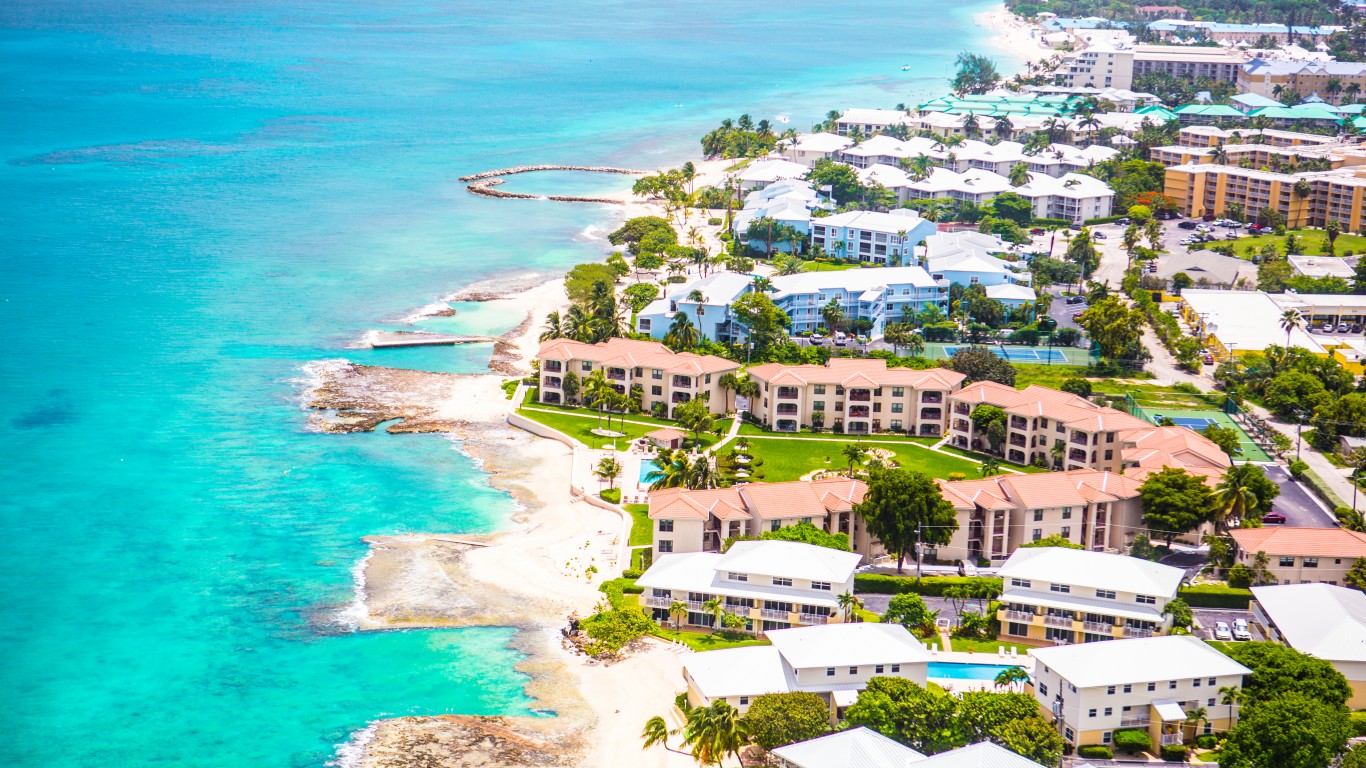
18. Cayman Islands
> GNI per capita: $58,100
> 2019 GDP: $5.0 billion
> Population: 65,720
> Avg. life expectancy at birth: N/A
The Cayman Islands is a small country just south of Cuba with a population of less than 66,000 people. Its economy is also relatively small, with a GDP of just under $5 billion as of 2019. Yet it ranks as one of the richest countries in the world with a GNI per capita of over $58,000.
Cayman Islands has among the highest GNI per capitas in the world because the country is a tax haven, imposing no income taxes on individuals, corporations, and it has no capital gains or property taxes either. The financial services industry makes up around half of the nation’s economy and a large share of government revenue.

17. Kuwait
> GNI per capita: $58,930
> 2019 GDP: $218.6 billion
> Population: 4.3 million
> Avg. life expectancy at birth: 75.5 years
Kuwait is one of the world’s richest countries with a GNI per capita of nearly $59,000. Much of the country’s economic activity comes from its oil and natural gas sector. Oil rents — the value of crude oil production minus the cost to produce it — accounts for over 42% of the country’s GDP.
All of the world’s richest countries tend to have relatively little corruption, according to Transparency International. Though Kuwait’s score of 42 out of 100 in TI’s 2020 Corruption Perceptions Index is low among the world’s richest countries, it is still higher than most nations. Corruption has been shown to hamper economic activity and growth by disincentivizing innovation and causing economic systems to work less efficiently.
[in-text-ad-2]

16. Austria
> GNI per capita: $58,940
> 2020 GDP: $491.3 billion
> Population: 8.9 million
> Avg. life expectancy at birth: 81.8 years
The value produced by Austria’s economy, as well as by Austrian companies and individuals in other countries, was $523.4 billion in 2020, or $58,940 per person. Higher incomes often lead to improved health outcomes, and Austria’s life expectancy at birth is over nine years higher than the worldwide expectancy, at 72.7 years.
A total of 41.3% of Austria’s population lives in rural areas — a higher share than any of the other wealthiest countries. Though this is high among wealthy countries, it is lower than the 43.8% share of people living in rural areas worldwide.

15. Iceland
> GNI per capita: $59,590
> 2020 GDP: $20.2 billion
> Population: 366,425
> Avg. life expectancy at birth: 82.6 years
Exports accounted for just 34.1% of Iceland’s GDP in 2020, higher than the 29.5% share of exports in worldwide GDP but one of the lowest shares among the world’s richest countries. Though it is not a member of the European Union, Iceland has a free trade agreement with the EU.
Iceland has been a popular tourist destination in recent years, but this aspect of its economy has been struggling even before the COVID-19 pandemic brought travel to a halt in 2020. Tourism began contracting in 2019, and Iceland’s WOW Air filed for bankruptcy that year.
[in-text-ad]

14. Netherlands
> GNI per capita: $59,700
> 2020 GDP: $1.0 trillion
> Population: 17.4 million
> Avg. life expectancy at birth: 82.0 years
The Netherlands is one of 25 countries in the world with a GDP of over $1 trillion. It also has the 14th highest GNI per capita in the world, at $59,700.
The Netherlands has one of the lowest Gini indexes in the world, indicating that incomes are relatively evenly distributed. Income inequality can reduce economic growth in a country because it can reduce demand for goods and services from low-income residents, while the wealthier residents save a larger share of their income rather than spend it.
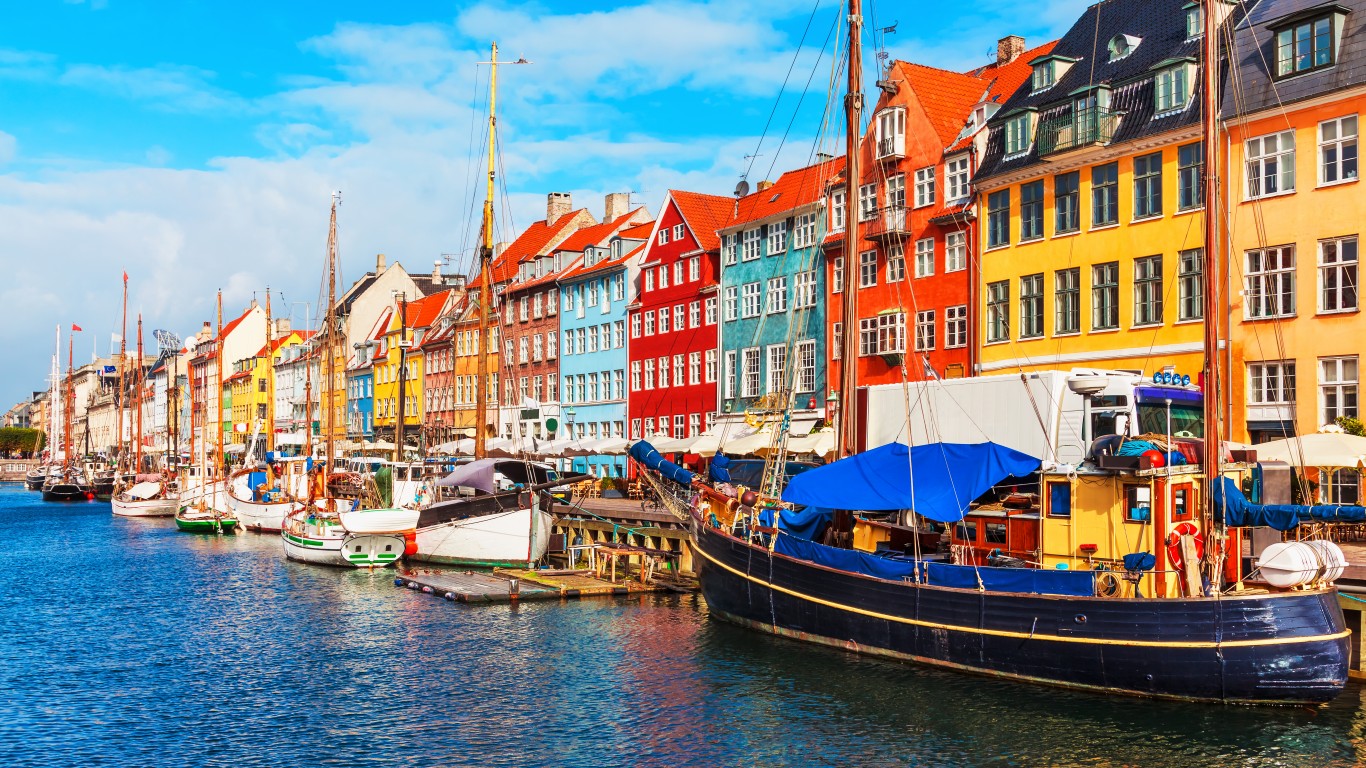
13. Denmark
> GNI per capita: $62,180
> 2020 GDP: $352.2 billion
> Population: 5.8 million
> Avg. life expectancy at birth: 81.2 years
Denmark is one of just 13 countries with a GNI per capita of over $60,000, at $62,180. It is one of the five Nordic countries, all of which rank among the world’s richest.
One of the aspects boosting Denmark’s economy is the lack of corruption. According to Transparency International, it ranks as the least corrupt country on Earth, tied with New Zealand. This lack of corruption allows people and businesses to operate freely, boosting competition and ultimately economic growth.

12. Hong Kong
> GNI per capita: $62,510
> 2020 GDP: $443.2 billion
> Population: 7.5 million
> Avg. life expectancy at birth: 85.1 years
Hong Kong is the 12th wealthiest country in the world, with a GNI per capita of $62,510. As one of the world’s busiest port cities, Hong Kong is one of the major exporters in the world as billions of dollars worth of electronics, precious metals, and machinery go through its port to destinations around the world each year.
Hong Kong is a special administrative region of China. Though it has its own legal and economic systems, it is still largely under the control of China — residents are only allowed to vote for representatives pre-selected by China.
[in-text-ad-2]

11. Norway
> GNI per capita: $66,020
> 2020 GDP: $340.0 billion
> Population: 5.4 million
> Avg. life expectancy at birth: 82.9 years
Norway has a GNI per capita of just over $66,000 — higher than all but 10 other countries in the world. It is the wealthiest of the Nordic nations, due in part to its nearly $60 billion of annual petroleum exports.
GNI per capita tends to correlate with health outcomes, and Norway is one of the prime examples. It has among the lowest rates of child mortality, maternal mortality, and tuberculosis per capita of any country in the world. Norwegians have a life expectancy over a decade longer than the average worldwide, at 82.9 years.

10. United States
> GNI per capita: $66,060
> 2020 GDP: $20.9 trillion
> Population: 329.5 million
> Avg. life expectancy at birth: 78.8 years
The U.S. is the 10th richest country in the world, with a GNI per capita of $66,060. The worldwide GNI per capita is $17,535. The U.S. is by far the largest country to rank among the world’s wealthiest. With nearly 330 million residents, it is actually larger than every other country on this list combined. It also has by far the largest economy on this list, at nearly $21 trillion, which ranks second in the world, trailing only China.
In spite of the size of its economy and relatively high GNI per capita, income inequality is a major issue in the U.S. To measure inequality, the World Bank uses the Gini index, where 0 represents perfectly equal incomes for everyone in the country, and 100 represents all income in a nation going to one person. The U.S.’s score is 41.4, the 29th most unequal of over 100 countries for which there is data. It is also the only one of the 25 richest countries with at least 1% of residents living in extreme poverty, or on $1.90 per day or less.
[in-text-ad]
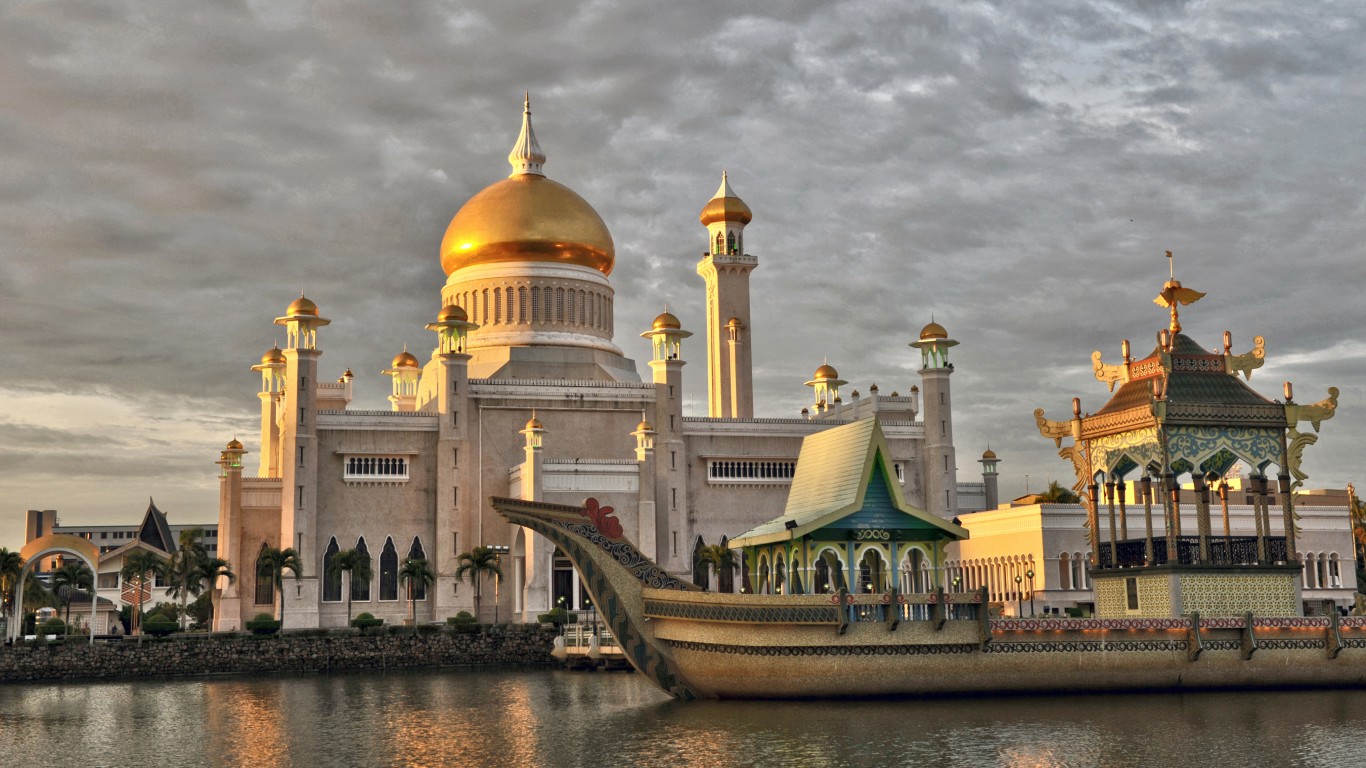
9. Brunei Darussalam
> GNI per capita: $66,460
> 2020 GDP: $28.7 billion
> Population: 437,483
> Avg. life expectancy at birth: 75.9 years
Brunei Darussalam, or simply Brunei, has the ninth highest gross national income per capita of countries in the world, at $66,460. Unlike most other countries on this list, it is not a democratic country but ruled by a sultan, who is an absolute monarch.
Like several other of the world’s richest countries, a significant share of economic activity in Brunei comes from its relatively large oil industry. Oil rents accounted for 11.6% of the nation’s $28.7 billion GDP, compared to oil rents’ 1.3% share of worldwide economic activity. More than 98% of Brunei’s exports are petroleum.

8. Ireland
> GNI per capita: $69,190
> 2020 GDP: $467.6 billion
> Population: 5.0 million
> Avg. life expectancy at birth: 82.3 years
Ireland ranks eighth on the list of the world’s wealthiest countries. All of Ireland’s businesses and individuals earned a total of $341 billion — both in Ireland and around the world — in 2019, or over $69,000 per person.
A number of foreign companies operate in Ireland due to favorable tax conditions introduced by the nation’s government to attract foreign investment — particularly large global tech companies like Google, Apple, Facebook, and more. This means that Ireland’s GDP is much higher than its GNI as the economic activity takes place in Ireland, but the actual income goes overseas.
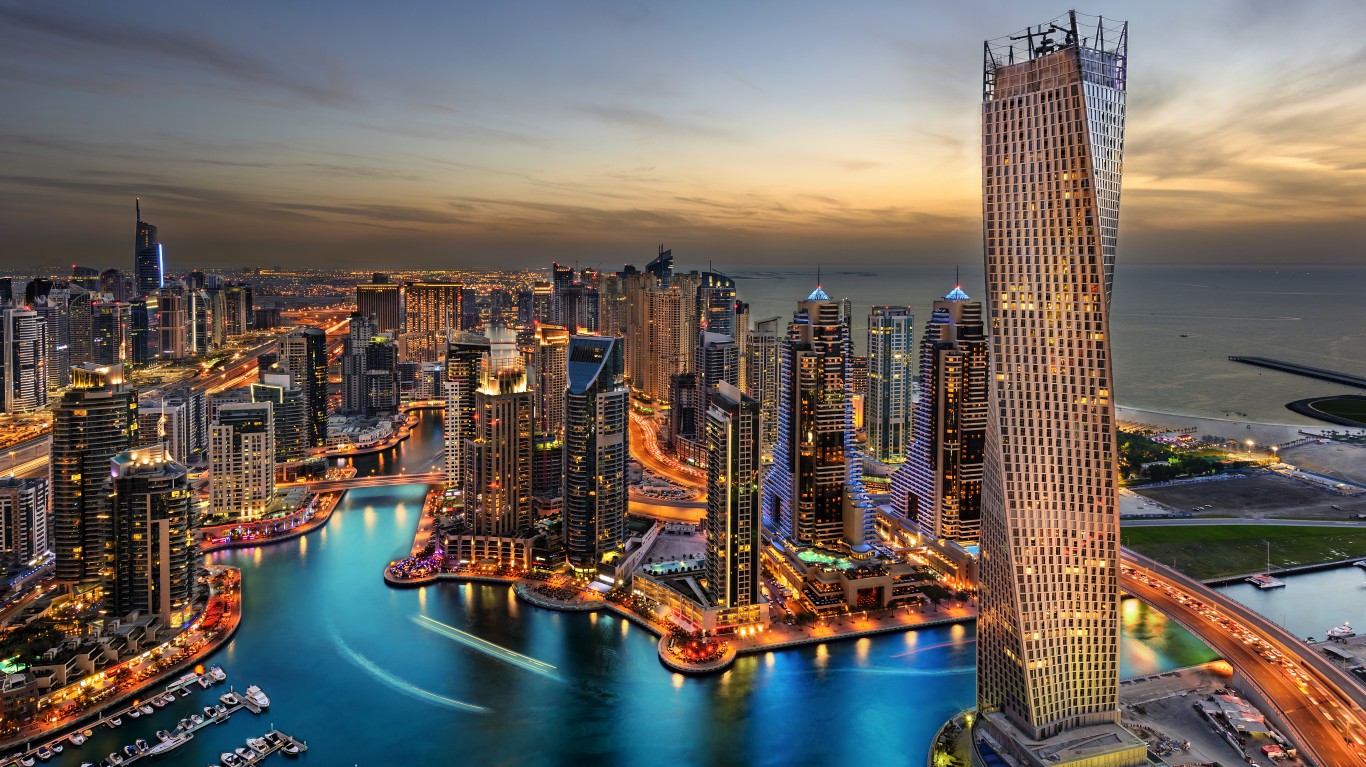
7. United Arab Emirates
> GNI per capita: $70,300
> 2019 GDP: $683.5 billion
> Population: 9.9 million
> Avg. life expectancy at birth: 78.0 years
The UAE is a relatively small Middle Eastern country, bordered by Oman, Saudi Arabia, and the Persian Gulf. It is one of seven countries in the world in which local economic activity and income from abroad add up to more than $70,000 per person.
More than 16% of all economic activity in the UAE comes from its oil industry, which is more than 10 times as much as is typical worldwide. The country’s mineral product exports were worth nearly $99 billion in 2019, or just under 40% of the nation’s exports.. UAE also exported billions of dollars worth of precious metals, machinery, cars, medicine, foodstuff, and more that year.
[in-text-ad-2]

6. Switzerland
> GNI per capita: $73,620
> 2020 GDP: $616.3 billion
> Population: 8.6 million
> Avg. life expectancy at birth: 83.7 years
Switzerland has a GNI per capita of $73,620, higher than all but five other countries in the world. Economic prosperity tends to correlate with improved health outcomes, and Switzerland’s average life expectancy at birth is 11 years higher than the worldwide average life expectancy.
Switzerland has one of the world’s most diverse economies, exporting goods like gold and medicine as well as services in sectors like business, finance, insurance, IT, and more. Economic diversity is correlated with growth, as countries with more diverse economies are able to compete with other countries in a number of sectors.

5. Luxembourg
> GNI per capita: $74,310
> 2020 GDP: $74.8 billion
> Population: 632,275
> Avg. life expectancy at birth: 82.4 years
Luxembourg is a small country located between Belgium, France, and Germany. Though it has just 630,000 residents, it is an economic powerhouse. Its GNI per capita of $74,310 is the fifth highest in the world, and the nation’s GDP per capita is by far the highest in the world, at $118,360. No other country’s GDP per capita exceeds six figures.
GNI differs from GDP in that it measures income earned by the country’s businesses and individuals in other nations. Luxembourg is known as a tax haven, with a top tax rate of less than 25%, which helps the country to attract $4 trillion in foreign direct investments. Therefore, much of the economic activity in the country is measured in the GNI of other nations. Luxembourg exports tens of billions of dollars worth of financial services annually. The size of its export economy is actually more than double its GDP, the only country in which this is the case.
[in-text-ad]

4. Bermuda
> GNI per capita: $86,450
> 2019 GDP: $5.4 billion
> Population: 63,903
> Avg. life expectancy at birth: 81.9 years
Bermuda is the world’s fourth richest country, with a GNI per capita of $86,450 — over $12,000 more than the next closest country. It also happens to be the smallest country to rank among the world’s richest, with less than 64,000 residents.
Bermuda is considered one of the world’s foremost tax havens — a place where businesses and individuals can set up shop to lower their taxable profits and incomes, even when primarily operating in other places. Income generated in other countries is then measured in the country’s GNI.

3. Singapore
> GNI per capita: $86,480
> 2020 GDP: $560.2 billion
> Population: 5.7 million
> Avg. life expectancy at birth: 83.5 years
With a GNI per capita of $86,480, Singapore ranks as one of the three richest countries in the world. Higher incomes help residents access education and health care. In Singapore, more than 97% of residents are literate, and the country has the fifth highest life expectancy at birth in the world, at 83.5 years.
Though Singapore’s GNI per capita ranks third in the world, at over $86,000, its GDP per capita ranks second, at over $98,000. This indicates that much of the economic activity taking place in the country financially benefits people and companies headquartered outside of Singapore.
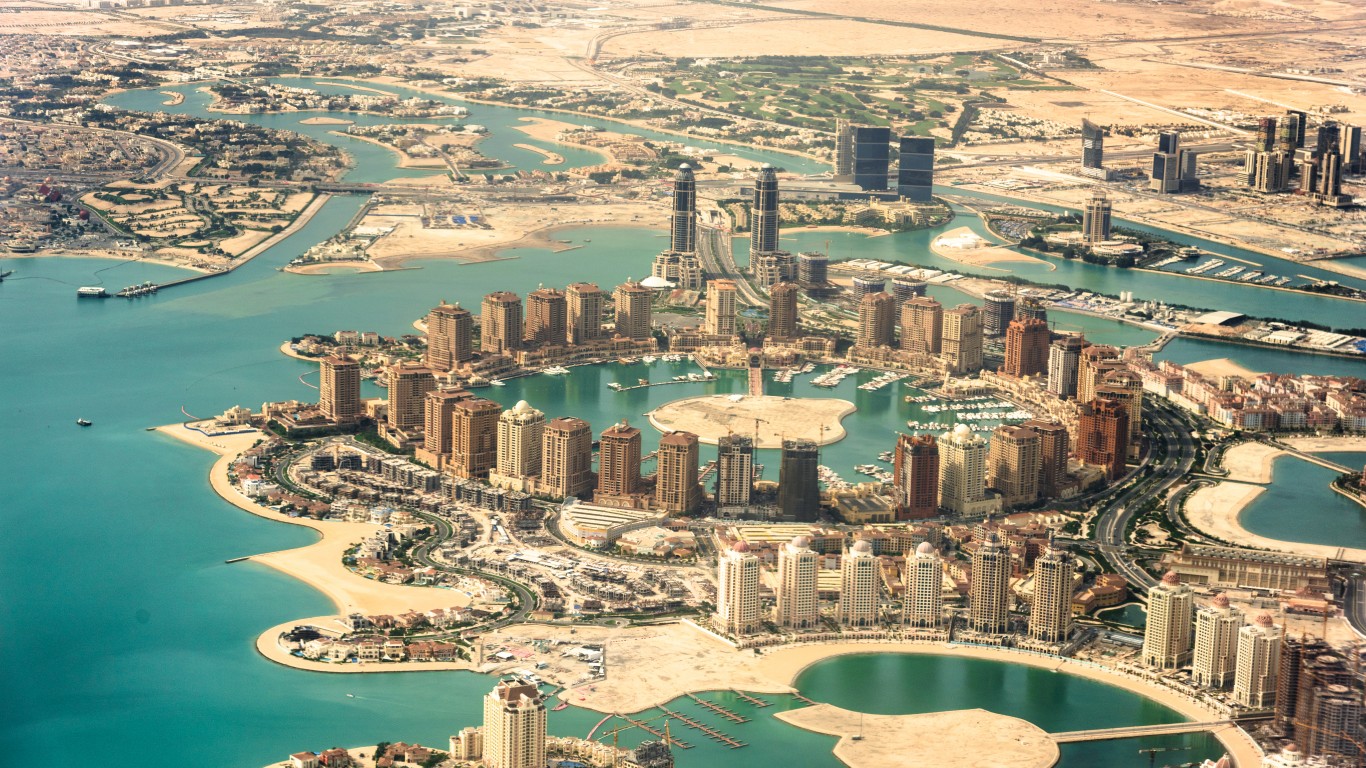
2. Qatar
> GNI per capita: $88,070
> 2020 GDP: $259.1 billion
> Population: 2.9 million
> Avg. life expectancy at birth: 80.2 years
Qatar has the second highest GNI per capita in the world, at just over $88,000. It is one of several nations on this list that derives much of its wealth from its oil and natural gas industry.
Qatar had $77 billion worth of exports in 2019, more than 88% of which came from crude and refined petroleum as well as petroleum gas. Qatar’s oil industry accounts for almost 17% of its GDP, one of the highest percentages in the world.
[in-text-ad-2]
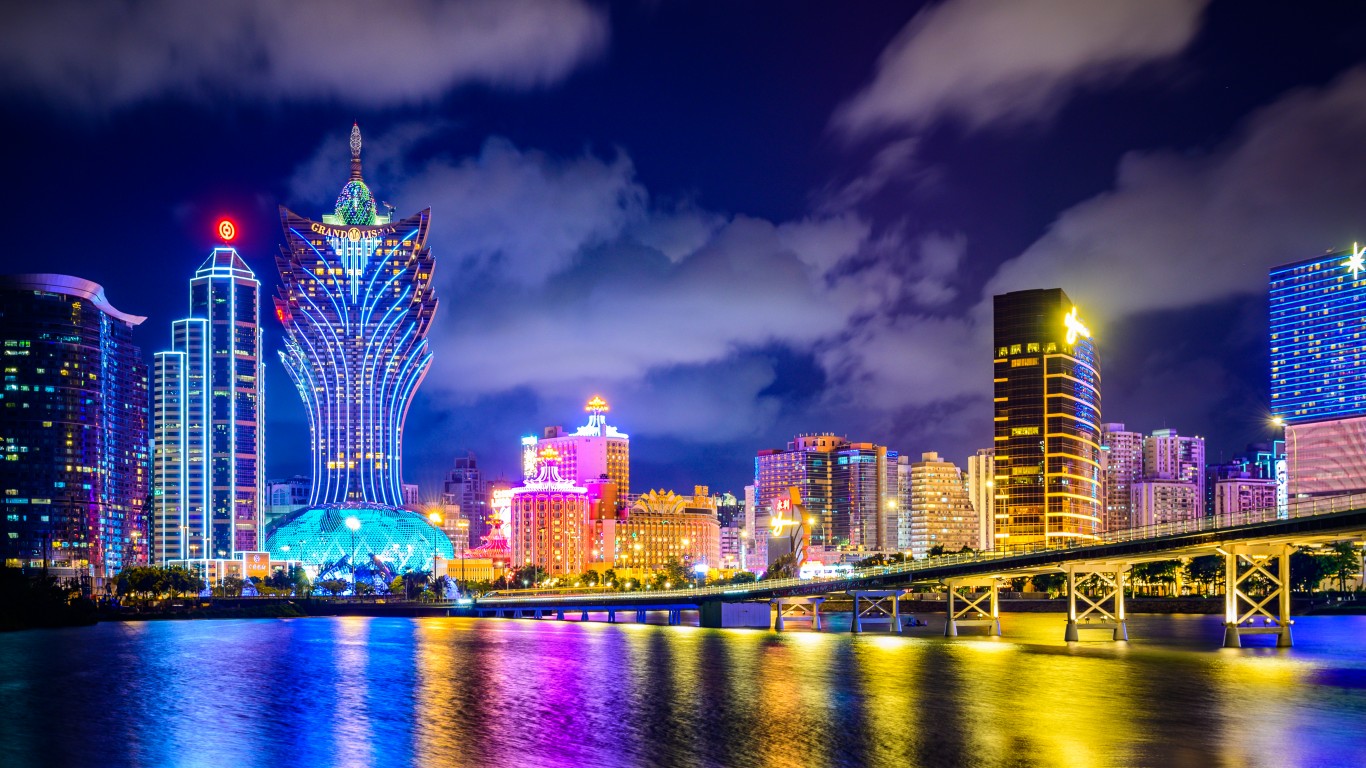
1. Macau
> GNI per capita: $117,340
> 2020 GDP: $37.5 billion
> Population: 649,342
> Avg. life expectancy at birth: 84.2 years
Macau is by far the richest country in the world, with a GNI per capita of $117,340 — nearly $100,000 higher than the worldwide GNI per capita and almost $30,000 more than the next closest country. Macau also ranks as one of the world’s healthiest countries with the average life expectancy at birth at 84.2 years, the third longest in the world.
A special administrative region of China located at China’s southern tip, Macau is known as the gambling capital of the world. Its economy relies heavily on tourism, though it is also considered a tax haven as foreign earnings are not taxed.
Methodology:
To determine the richest country in the world, 24/7 Wall St. reviewed data on gross national income per capita for 193 countries and special regions with available data from the World Bank. The World Bank estimates GNI per capita using the purchasing power parity method, and figures are in current international dollars. All data on GNI per capita is based on the most recent available year for a given country.
Additional data, measuring GDP in current international dollars, population, life expectancy at birth, and access to electricity also came from the World Bank. All data are for the most recent year available for every country.
We also considered data on levels of public sector corruption in 2020 from the nonprofit, international watchdog and anti-corruption group, Transparency International.
100 Million Americans Are Missing This Crucial Retirement Tool
The thought of burdening your family with a financial disaster is most Americans’ nightmare. However, recent studies show that over 100 million Americans still don’t have proper life insurance in the event they pass away.
Life insurance can bring peace of mind – ensuring your loved ones are safeguarded against unforeseen expenses and debts. With premiums often lower than expected and a variety of plans tailored to different life stages and health conditions, securing a policy is more accessible than ever.
A quick, no-obligation quote can provide valuable insight into what’s available and what might best suit your family’s needs. Life insurance is a simple step you can take today to help secure peace of mind for your loved ones tomorrow.
Click here to learn how to get a quote in just a few minutes.
Thank you for reading! Have some feedback for us?
Contact the 24/7 Wall St. editorial team.
 24/7 Wall St.
24/7 Wall St. 24/7 Wall St.
24/7 Wall St. 24/7 Wall St.
24/7 Wall St.
